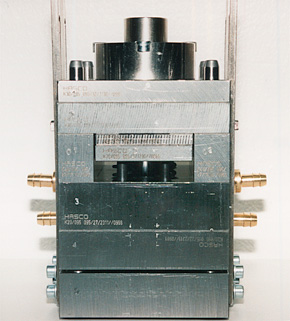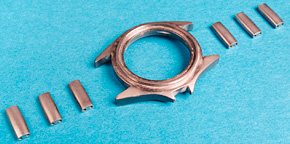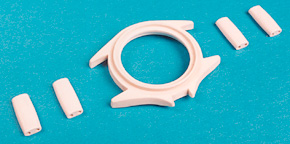MEDPIMOLD Technology
The technology to produce ceramic or metallic parts by Medium Pressure Powder Injection Molding is straightforward and includes the following steps:
- Powder pre-processing
- Feedstock preparation
- Medium pressure injection molding
- Binder removal by thermal evaporation or supercritical CO2 extraction
- Sintering
A high-solid content mixture (feedstock) of ceramic or metal powder and a wax-based binder is melted and injected under pressure into a tempered one- or multi-cavity mold tool. The solidified molded part is then ejected from the tool, and the organic binder is removed thermally in a debinding furnace or, alternatively, by supercritical extraction. The remaining powder body is sintered (fired) in a furnace at high temperature to a dense, high- strength component. Typical linear shrinkage during sintering is 10-15 percent.




- Stainless 316 Steel
- High-Speed Steel (HSS)
- Low-Alloy Steel
- Iron
- Tungsten Carbide
- Tungsten
- Cobalt
- Titanium
- Alumina
- Zirconia
- Silicon Nitride
- Silicon Carbide
- PZT (Piezo material)
- Leucite
- Steatite
- Glass
A relative comparison of different PIM technologies
| Type of injection | Molding technique | MEDPIMOLD | |
|---|---|---|---|
| High pressure | Low pressure | Medium pressure | |
| Investment cost | high | low | medium |
| Molding tool cost | high | low | low |
| Service cost | medium | low | low |
| Automation capability | good | unknown | good |
| Prototyping capability | poor | good | good |
Equipment and technologies
The GOCERAM production line includes:
- Feedstock Mixers for rapid homogenisation of powder and binder
- Medium Pressure Injection Molding (MPIM) Machines for cost-effective shaping of complex components using environment-friendly wax-based binder systems
- Debinding Furnaces without or with weight loss rate control, documenting the removal of binders and other volatiles from green parts in various atmospheres
- Supercritical CO2 Extraction Equipment facilitating high-speed production of thin- and thick-walled parts to very fine tolerances
- Specially designed sintering furnaces
- Automation equipment
Experienced customers may purchase selected machinery only. For customers completely new to the technology, Goceram will be involved all the way from the first test run to the start up of the production at the client’s manufacturing site.
Please contact us if you want us to carry out a test run of a specific material and component according to your wishes. We will do this as a technical service and share the cost between us. Such a run will help you to decide that MEDPIMOLD is the technique you should choose for the production of complex shaped parts of almost any material.
The trademark MEDPIMOLD® covers all the machinery and technology related to the Medium Pressure Powder Injection Molding technique.


